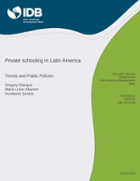Private Schooling in Latin America: Trends and Public Policies
Date
Oct 2018
Over the last 25 years, more than two-thirds of OECD countries have increased school choice opportunities for parents. For example, in recent years, new forms of delivery like government-dependent private schools have flourished in nearly all of the OECD countries by using policies such as open enrollment in public schools and several forms of public-private partnerships (e.g. school vouchers, charter schools, and magnet schools). Although Latin America is one of the regions with the greatest private sector participation and expansion in the world, there is scant information on the policies countries have adopted to strengthen parental choice and incorporate private schools into the public system. To fill this knowledge gap, in this report we first explore private school trends in Latin America, using available census data and administrative records in each country, and then we review the policies adopted by Latin American countries to strengthen their mixed schooling systems. The review of these policies is to focus mainly on the specific design and implementation features and on the evidence of their impact on efficiency and equity. We characterize policies into three dimensions: i) the design and regulations of public funding of private schools; ii) school admission systems; and iii) information and accountability.
After reviewing the evidence and country cases studied in this report, we conclude with a set of recommendations that could provide Latin-American countries and other middle- and low-income countries with a high proportion of students enrolled in private schools, with a policy road map to introduce finance and regulations that promote quality and equity.
First, we show that financing policies that are part of a governmental system, tied to effective regulations on the quality of education provided by schools and that take into account family and school background characteristics have a positive impact on student performance and equity. Second, we examine centralized admission systems in the region and conclude that the implementation of these systems is consistent with the trend in countries that have introduced school choice to families, since they are a fair, efficient, and transparent way to allocate vacancies in schools. Third, we review information and accountability policies in LAC. We find that many countries in the region apply standardized tests at different levels. However, in most countries, the results are only used to provide feedback directly to schools and to target support programs. Very few school systems in the region use the results to provide incentives for parents, schools, and teachers. The evidence also sheds light on the importance of designing the rules so that schools respond to these pressures by introducing policies and practices that aim to improve learning and narrow the achievement gap taking into account quality and equity.
The results of this work will contribute to our understanding of how educational markets work in different contexts. We also hope to set forth an agenda for the future study and practice of school choice and private schooling in the region. Rather than ask whether school choice is an effective reform, the goal of this report is to study the policies that school systems with a high proportion of private schools in the region are implementing in practice.
After reviewing the evidence and country cases studied in this report, we conclude with a set of recommendations that could provide Latin-American countries and other middle- and low-income countries with a high proportion of students enrolled in private schools, with a policy road map to introduce finance and regulations that promote quality and equity.
First, we show that financing policies that are part of a governmental system, tied to effective regulations on the quality of education provided by schools and that take into account family and school background characteristics have a positive impact on student performance and equity. Second, we examine centralized admission systems in the region and conclude that the implementation of these systems is consistent with the trend in countries that have introduced school choice to families, since they are a fair, efficient, and transparent way to allocate vacancies in schools. Third, we review information and accountability policies in LAC. We find that many countries in the region apply standardized tests at different levels. However, in most countries, the results are only used to provide feedback directly to schools and to target support programs. Very few school systems in the region use the results to provide incentives for parents, schools, and teachers. The evidence also sheds light on the importance of designing the rules so that schools respond to these pressures by introducing policies and practices that aim to improve learning and narrow the achievement gap taking into account quality and equity.
The results of this work will contribute to our understanding of how educational markets work in different contexts. We also hope to set forth an agenda for the future study and practice of school choice and private schooling in the region. Rather than ask whether school choice is an effective reform, the goal of this report is to study the policies that school systems with a high proportion of private schools in the region are implementing in practice.




